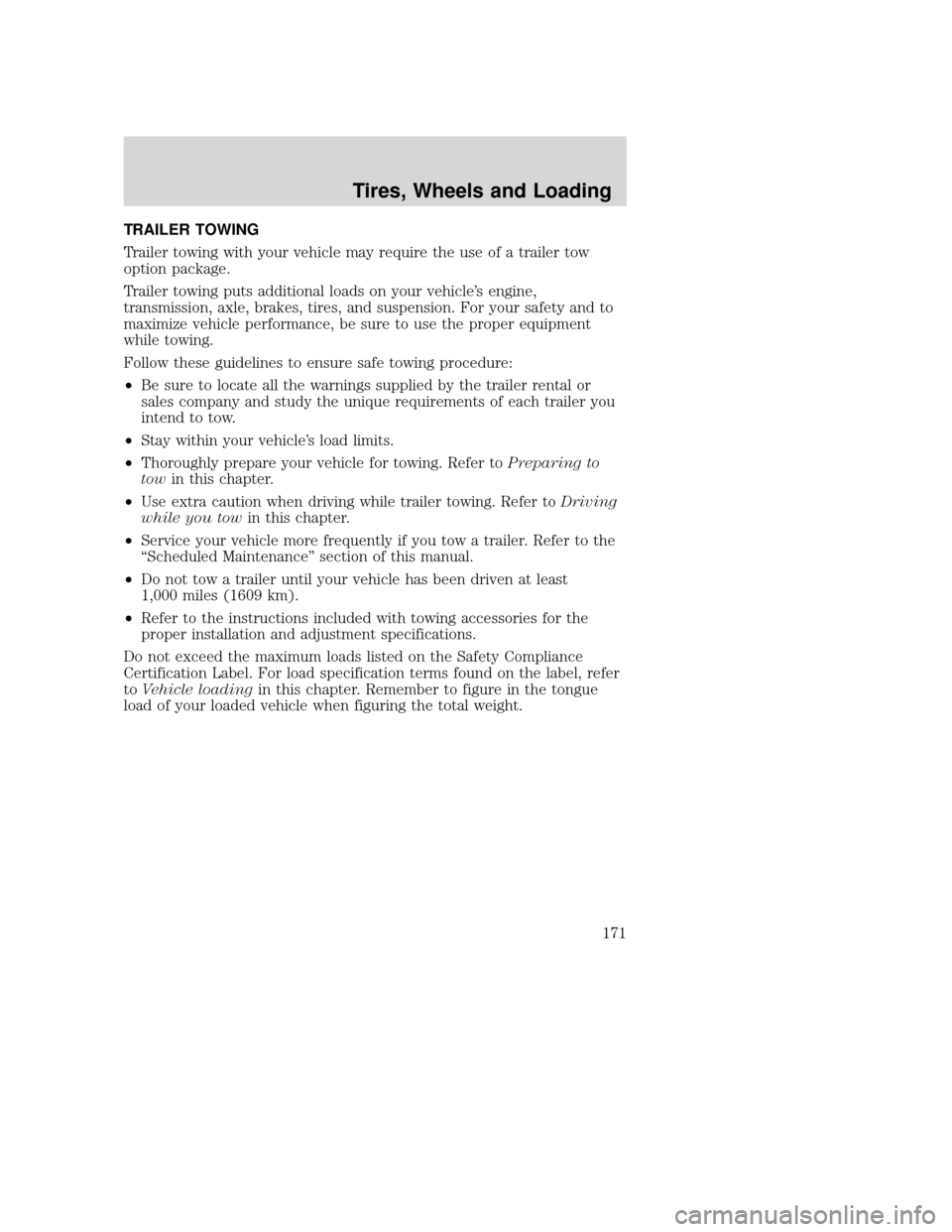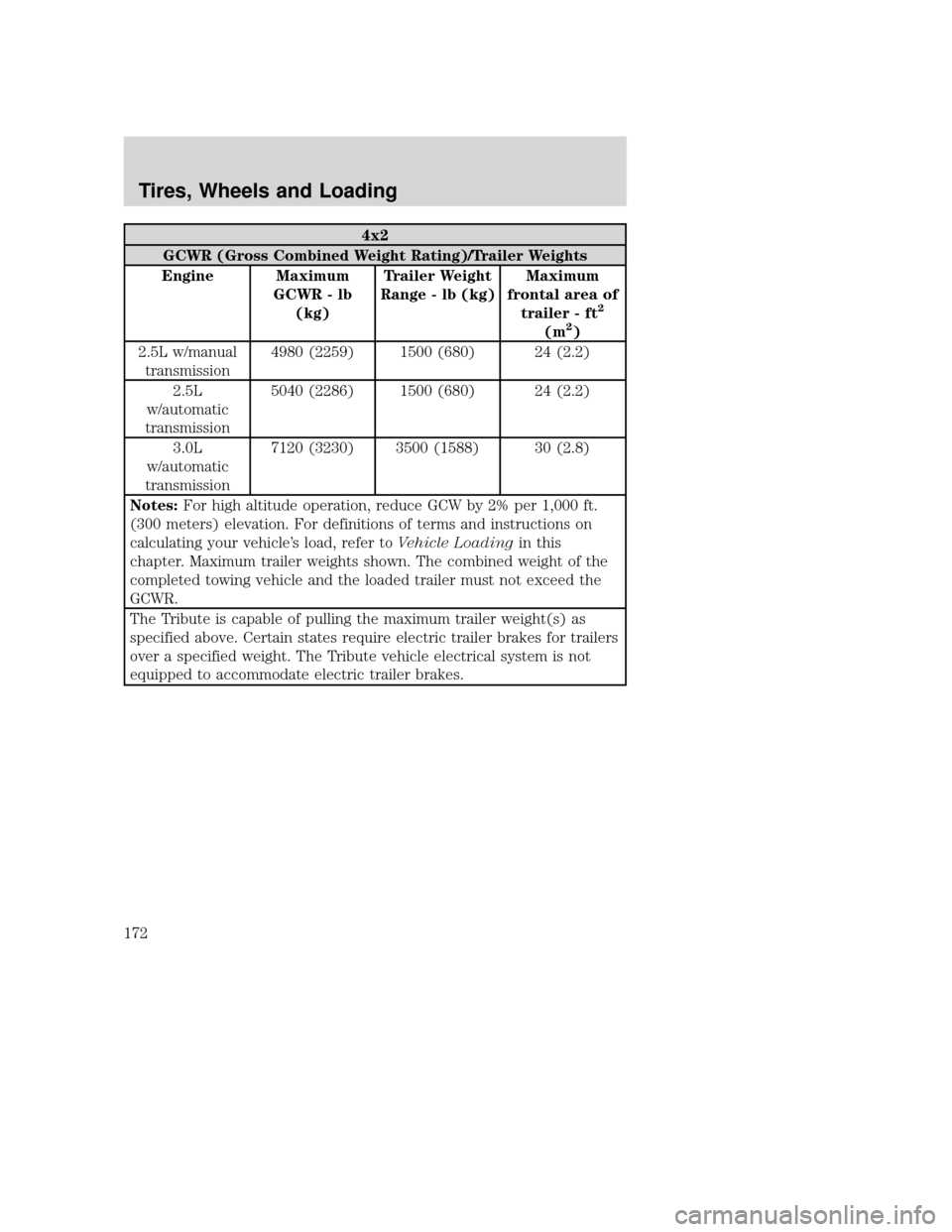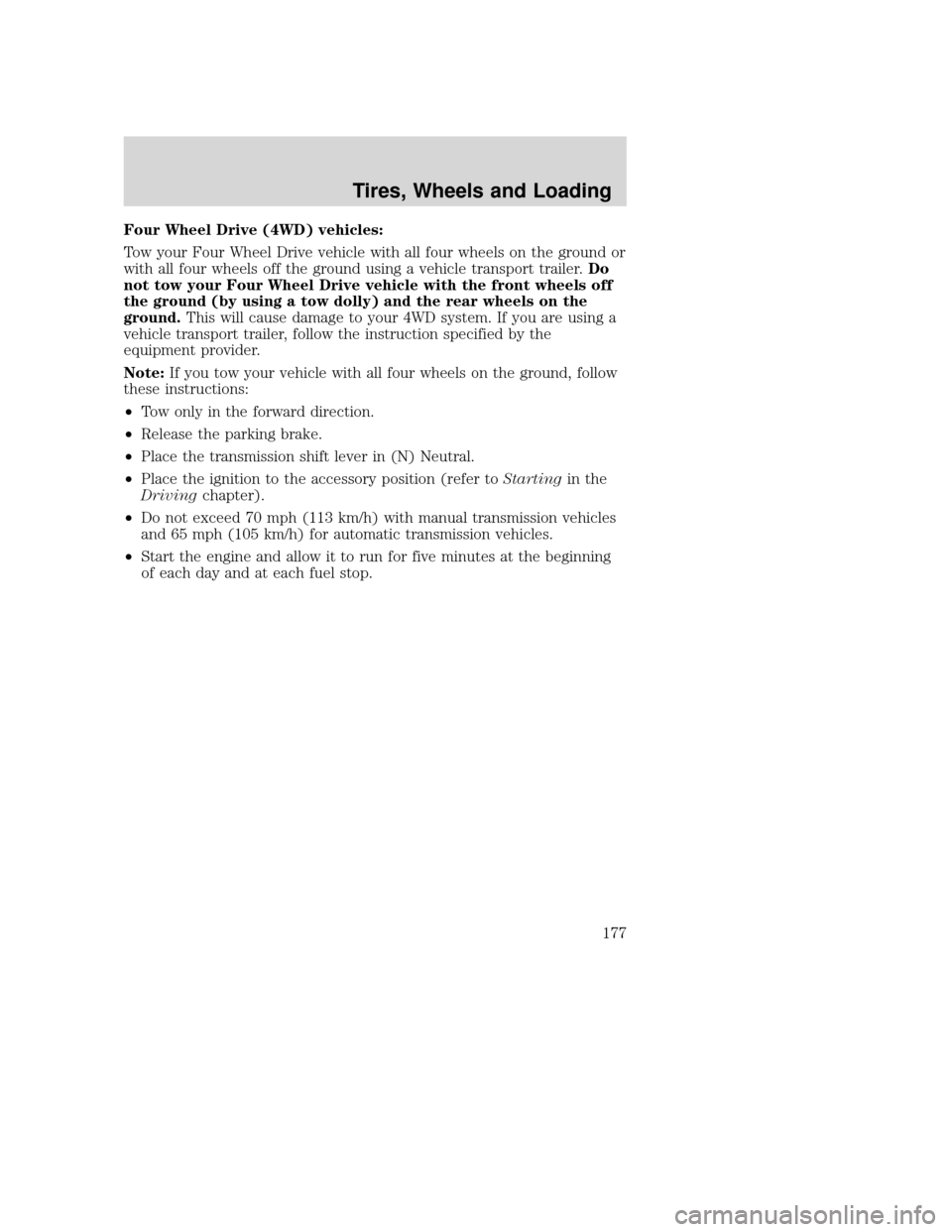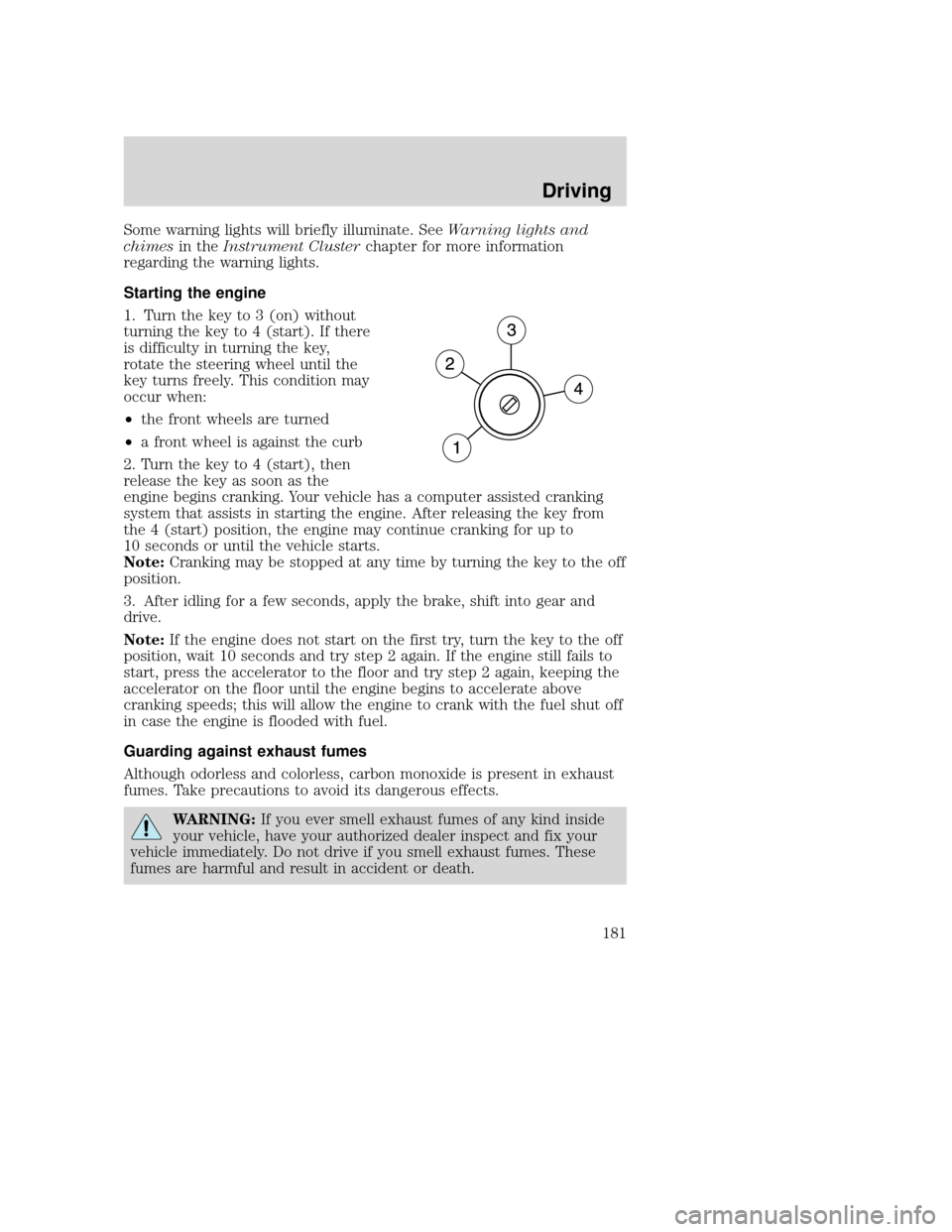engine MAZDA MODEL TRIBUTE 2009 (in English) Owner's Manual
[x] Cancel search | Manufacturer: MAZDA, Model Year: 2009, Model line: MODEL TRIBUTE, Model: MAZDA MODEL TRIBUTE 2009Pages: 304, PDF Size: 1.97 MB
Page 168 of 304

WARNING:Exceeding the Safety Compliance Certification Label
vehicle weight rating limits could result in substandard vehicle
handling or performance, engine, transmission and/or structural
damage, serious damage to the vehicle, loss of control and personal
injury.
GCW (Gross Combined Weight) – is the weight of the loaded vehicle
(GVW) plus the weight of the fully loaded trailer.
GCWR (Gross Combined Weight Rating) – is the maximum allowable
weight of the vehicle and the loaded trailer – including all cargo and
passengers – that the vehicle can handle without risking damage.
(Important: The towing vehicle’s braking system is rated for operation at
GVWR, not at GCWR.) Separate functional brakes should be used for
safe control of towed vehicles and for trailers where the GCW of the
towing vehicle plus the trailer exceed the GVWR of the towing vehicle.
The GCW must never exceed the GCWR.
Maximum Loaded Trailer Weight – is the highest possible weight of a
fully loaded trailer the vehicle can tow. It assumes a vehicle with only
mandatory options, no cargo (internal or external), a tongue load of
10–15% (conventional trailer) or king pin weight of 15–25% (fifth wheel
trailer), and driver only (150 lb. [68 kg]). Consult your authorized
dealer (or the RV and Trailer Towing Guide provided by your
authorized dealer) for more detailed information.
Tongue Load or Fifth Wheel King Pin Weight – refers to the amount
of the weight that a trailer pushes down on a trailer hitch.
Examples: For a 5,000 lb. (2,268 kg) conventional trailer, multiply 5,000
by 0.10 and 0.15 to obtain a proper tongue load range of 500 to 750 lb.
(227 to 340 kg). For an 11,500 lb. (5,216 kg) fifth wheel trailer, multiply
by 0.15 and 0.25 to obtain a proper king pin load range of 1,725 to
2,875 lb. (782 to 1,304 kg)
WARNING: Do not exceed the GVWR or the GAWR specified on
the Safety Compliance Certification Label.
2009 Tribute (j14)
Owners Guide, 1st Printing
USA (fus)
Tires, Wheels and Loading
168
Page 171 of 304

TRAILER TOWING
Trailer towing with your vehicle may require the use of a trailer tow
option package.
Trailer towing puts additional loads on your vehicle’s engine,
transmission, axle, brakes, tires, and suspension. For your safety and to
maximize vehicle performance, be sure to use the proper equipment
while towing.
Follow these guidelines to ensure safe towing procedure:
•Be sure to locate all the warnings supplied by the trailer rental or
sales company and study the unique requirements of each trailer you
intend to tow.
• Stay within your vehicle’s load limits.
• Thoroughly prepare your vehicle for towing. Refer to Preparing to
tow in this chapter.
• Use extra caution when driving while trailer towing. Refer to Driving
while you tow in this chapter.
• Service your vehicle more frequently if you tow a trailer. Refer to the
“Scheduled Maintenance” section of this manual.
• Do not tow a trailer until your vehicle has been driven at least
1,000 miles (1609 km).
• Refer to the instructions included with towing accessories for the
proper installation and adjustment specifications.
Do not exceed the maximum loads listed on the Safety Compliance
Certification Label. For load specification terms found on the label, refer
to Vehicle loading in this chapter. Remember to figure in the tongue
load of your loaded vehicle when figuring the total weight.
2009 Tribute (j14)
Owners Guide, 1st Printing
USA (fus)
Tires, Wheels and Loading
171
Page 172 of 304

4x2
GCWR (Gross Combined Weight Rating)/Trailer Weights
Engine Maximum GCWR - lb(kg) Trailer Weight
Range - lb (kg) Maximum
frontal area of trailer - ft
2
(m2)
2.5L w/manual transmission 4980 (2259) 1500 (680) 24 (2.2)
2.5L
w/automatic
transmission 5040 (2286) 1500 (680) 24 (2.2)
3.0L
w/automatic
transmission 7120 (3230) 3500 (1588) 30 (2.8)
Notes: For high altitude operation, reduce GCW by 2% per 1,000 ft.
(300 meters) elevation. For definitions of terms and instructions on
calculating your vehicle’s load, refer to Vehicle Loadingin this
chapter. Maximum trailer weights shown. The combined weight of the
completed towing vehicle and the loaded trailer must not exceed the
GCWR.
The Tribute is capable of pulling the maximum trailer weight(s) as
specified above. Certain states require electric trailer brakes for trailers
over a specified weight. The Tribute vehicle electrical system is not
equipped to accommodate electric trailer brakes.
2009 Tribute (j14)
Owners Guide, 1st Printing
USA (fus)
Tires, Wheels and Loading
172
Page 173 of 304

4x4
GCWR (Gross Combined Weight Rating)/Trailer Weights
Engine Maximum GCWR - lb(kg) Trailer Weight
Range - lb (kg) Maximum
frontal area of trailer - ft
2
(m2)
2.5L
w/automatic
transmission 5180 (2350) 1500 (680) 24 (2.2)
3.0L
w/automatic
transmission 7260 (3293) 3500 (1588) 30 (2.8)
Notes: For high altitude operation, reduce GCW by 2% per 1,000 ft.
(300 meters) elevation. For definitions of terms and instructions on
calculating your vehicle’s load, refer to Vehicle Loadingin this
chapter. Maximum trailer weights shown. The combined weight of the
completed towing vehicle and the loaded trailer must not exceed the
GCWR.
The Tribute is capable of pulling the maximum trailer weight(s) as
specified above. Certain states require electric trailer brakes for trailers
over a specified weight. The Tribute vehicle electrical system is not
equipped to accommodate electric trailer brakes.
WARNING: Do not exceed the GVWR or the GAWR specified on
the certification label.
Towing trailers beyond the maximum recommended gross trailer weight
exceeds the limit of the vehicle and could result in:
• engine damage
• transmission damage
• structural damage
• loss of control
• personal injury
Preparing to tow
Use the proper equipment for towing a trailer and make sure it is
properly attached to your vehicle. See your authorized Mazda dealer.
2009 Tribute (j14)
Owners Guide, 1st Printing
USA (fus)
Tires, Wheels and Loading
173
Page 175 of 304

•Turn off the speed control. The speed control may shut off
automatically when you are towing on long, steep grades.
• Consult your local motor vehicle speed regulations for towing a trailer.
• To eliminate excessive shifting, use a lower gear. This will also assist
in transmission cooling. For additional information, refer to Automatic
transmission operation in theDriving chapter.
• Anticipate stops and brake gradually.
• Do not exceed the GCWR rating or transmission damage may occur.
Servicing after towing
If you tow a trailer for long distances, your vehicle will require more
frequent service intervals. Refer to your scheduled maintenance
information for more information.
Trailer towing tips
• Practice turning, stopping and backing up before starting on a trip to
get the feel of the vehicle trailer combination. When turning, make
wider turns so the trailer wheels will clear curbs and other obstacles.
• If you are driving down a long or steep hill, shift to a lower gear. Do
not apply the brakes continuously, as they may overheat and become
less effective.
• Allow more distance for stopping with a trailer attached.
• The trailer tongue weight should be 10–15% of the loaded trailer
weight.
• After you have traveled 50 miles (80 km), thoroughly check your
hitch, electrical connections and trailer wheel lug nuts.
• To aid in engine/transmission cooling and A/C efficiency during hot
weather while stopped in traffic, place the gearshift lever in P (Park)
(automatic transmission) or N (Neutral) (manual transmissions).
• Vehicles with trailers should not be parked on a grade. If you must
park on a grade, place wheel chocks under the trailer’s wheels.
Launching or retrieving a boat
When backing down a ramp during boat launching or retrieval,
• Do not allow the static water level to rise above the bottom edge of
the rear bumper.
• Do not allow waves to break higher than 6 inches (15 cm) above the
bottom edge of the rear bumper.
2009 Tribute (j14)
Owners Guide, 1st Printing
USA (fus)
Tires, Wheels and Loading
175
Page 176 of 304

Exceeding these limits may allow water to enter critical vehicle
components, adversely affecting driveability, emissions, reliability
and causing internal transmission damage.
Replace the rear axle lubricant any time the axle has been
submerged in water. Rear axle lubricant quantities are not to be
checked or changed unless a leak is suspected or repair required.
Disconnect the wiring to the trailer before backing the trailer into the
water. Reconnect the wiring to the trailer after the trailer is removed
from the water. Water entering these areas, while connected, could
short-circuit the system.
RECREATIONAL TOWING
Follow these guidelines for your specific powertrain combination to tow
your vehicle for personal travel (such as behind a motor home or a
truck).
In case of roadside emergency with a disabled vehicle, please refer to
Wrecker towingin theRoadside Emergencies chapter.
These guidelines are designed to prevent damage to your vehicle.
Front Wheel Drive (FWD) vehicles:
Tow your Front Wheel Drive vehicle with all four wheels on the ground
or with the front wheels off the ground by using a tow dolly. If you are
using a tow dolly follow the instructions specified by the equipment
provider.
Note: If you tow your vehicle with all four wheels on the ground, follow
these instructions:
• Tow only in the forward direction.
• Release the parking brake.
• Place the transmission shift lever in (N) Neutral.
• Place the ignition to the accessory position (refer to Startingin the
Driving chapter).
• Do not exceed 70 mph (113 km/h) with manual transmission vehicles
and 65 mph (105 km/h) for automatic transmission vehicles.
• Start the engine and allow it to run for five minutes at the beginning
of each day and at each fuel stop.
2009 Tribute (j14)
Owners Guide, 1st Printing
USA (fus)
Tires, Wheels and Loading
176
Page 177 of 304

Four Wheel Drive (4WD) vehicles:
Tow your Four Wheel Drive vehicle with all four wheels on the ground or
with all four wheels off the ground using a vehicle transport trailer.Do
not tow your Four Wheel Drive vehicle with the front wheels off
the ground (by using a tow dolly) and the rear wheels on the
ground. This will cause damage to your 4WD system. If you are using a
vehicle transport trailer, follow the instruction specified by the
equipment provider.
Note: If you tow your vehicle with all four wheels on the ground, follow
these instructions:
• Tow only in the forward direction.
• Release the parking brake.
• Place the transmission shift lever in (N) Neutral.
• Place the ignition to the accessory position (refer to Startingin the
Driving chapter).
• Do not exceed 70 mph (113 km/h) with manual transmission vehicles
and 65 mph (105 km/h) for automatic transmission vehicles.
• Start the engine and allow it to run for five minutes at the beginning
of each day and at each fuel stop.
2009 Tribute (j14)
Owners Guide, 1st Printing
USA (fus)
Tires, Wheels and Loading
177
Page 178 of 304

STARTING
Positions of the ignition1. Off— locks the gearshift lever and steering column and allows
key removal.
2. Accessory— allows the electrical accessories such as
the radio to operate while the
engine is not running.
3. On— all electrical circuits operational and warning lights
will illuminate. This is the
position the key is in when you’re driving.
4. Start— cranks the engine. Release the key as soon as the engine starts.
Preparing to start your vehicle
Engine starting is controlled by the powertrain control system.
Note: This system meets all Canadian Interference-Causing Equipment
standard requirements regulating the impulse electrical field strength of
radio noise.
When starting a fuel-injected engine, avoid pressing the accelerator
before or during starting. Only use the accelerator when you have
difficulty starting the engine. For more information on starting the
vehicle, refer to Starting the engine in this chapter.
WARNING:Extended idling at high engine speeds can produce
very high temperatures in the engine and exhaust system,
creating the risk of fire or other damage.
WARNING: Do not park, idle, or drive your vehicle in dry grass
or other dry ground cover. The emission system heats up the
engine compartment and exhaust system, which can start a fire.
WARNING: Do not start your vehicle in a closed garage or in
other enclosed areas. Exhaust fumes can be toxic. Always open
the garage door before you start the engine. See Guarding against
exhaust fumes in this chapter for more instructions.
2009 Tribute(j14)
Owners Guide, 1st Printing
USA (fus)
Driving
178
Page 179 of 304

WARNING:If you smell exhaust fumes inside your vehicle, have
your authorized dealer inspect your vehicle immediately. Do not
drive if you smell exhaust fumes.
Important safety precautions
A computer system controls the engine’s idle revolutions per minute
(RPM). When the engine starts, the idle RPM runs higher than normal in
order to warm the engine. If the engine idle speed does not slow down
automatically, have the vehicle checked by your authorized dealer.
Before starting the vehicle: 1. Make sure all vehicle occupants have buckled their seat belts. For more information on seat belts and their proper usage, refer to the
Seating and Safety Restraints chapter.
2. Make sure the headlamps and vehicle accessories are off.
If starting a vehicle with an
automatic transmission:
• Make sure the parking brake is
set.
BRAKE RELEASE P
2009 Tribute (j14)
Owners Guide, 1st Printing
USA (fus)
Driving
179
Page 181 of 304

Some warning lights will briefly illuminate. SeeWarning lights and
chimes in theInstrument Cluster chapter for more information
regarding the warning lights.
Starting the engine
1. Turn the key to 3 (on) without
turning the key to 4 (start). If there
is difficulty in turning the key,
rotate the steering wheel until the
key turns freely. This condition may
occur when:
• the front wheels are turned
• a front wheel is against the curb
2. Turn the key to 4 (start), then
release the key as soon as the
engine begins cranking. Your vehicle has a computer assisted cranking
system that assists in starting the engine. After releasing the key from
the 4 (start) position, the engine may continue cranking for up to
10 seconds or until the vehicle starts.
Note: Cranking may be stopped at any time by turning the key to the off
position.
3. After idling for a few seconds, apply the brake, shift into gear and
drive.
Note: If the engine does not start on the first try, turn the key to the off
position, wait 10 seconds and try step 2 again. If the engine still fails to
start, press the accelerator to the floor and try step 2 again, keeping the
accelerator on the floor until the engine begins to accelerate above
cranking speeds; this will allow the engine to crank with the fuel shut off
in case the engine is flooded with fuel.
Guarding against exhaust fumes
Although odorless and colorless, carbon monoxide is present in exhaust
fumes. Take precautions to avoid its dangerous effects.
WARNING: If you ever smell exhaust fumes of any kind inside
your vehicle, have your authorized dealer inspect and fix your
vehicle immediately. Do not drive if you smell exhaust fumes. These
fumes are harmful and result in accident or death.
2009 Tribute (j14)
Owners Guide, 1st Printing
USA (fus)
Driving
181